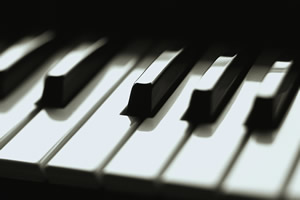Piano Lessons - Seventh Chords
Chords are the basis for harmony in music. Learning to play chords on the piano will make you a versatile musician, able to harmonize, improvise, and increase your overall skill in playing piano music. One variety of chord that has a lot of uses is the seventh chord. To talk about the seventh chord, you first need to understand what an interval is.
An interval is the name for the distance between two notes. The distance between an A on the second space of the treble clef, for example, and the B directly above it is called a second. It doesn’t matter if the notes are sharp, flat, or natural, we still refer to them as being a second apart. The distance from the A to the C on the third space would be called a third, A to D would be a fourth, and so on. A seventh chord starts out with a triad. A triad consists most often of three notes: the root, the third, and the fifth. The lowest note is the root, and the next note is called the third because it is an interval of a third above the root. The highest note is called the fifth, again because it is an interval of a fifth above the root. An example of a triad would be C, E, G. If you play these notes on the piano, you may recognize the familiar sound. The seventh chord adds one extra note to this triad, an interval of a seventh above the root (the lowest note). This would make the triad above now include C, E, G, and B. If you play these notes, you can hear the distinct seventh chord sound.
There are several different types of seventh chords that can be used, depending on the quality of the intervals that are used, whether they are major, minor, diminished, or augmented. Calling a triad a major triad simply means that all of the notes are found within the key of the root. Our C, E, and G example triad is called a C major triad, because in the key of C, all of these notes are natural. When the third is lowered half a step, now giving us C, Eb, and G, we call the triad a minor triad. When you talk about seventh chords, there are a few different varieties. The easiest one to understand is a major seventh chord, which is built using a major triad, and a major seventh above the root. A major/minor seventh chord would consist of a major triad with a minor seventh above the root. This would mean that the seventh would be lowered half a step from the note that would normally be found in the root’s key signature. The more you work with seventh chords, the more comfortable you will be using them and all of their varieties. A good way to become more comfortable building seventh chords is to make a chart, listing all of the key signatures and writing the notes for a major triad for each of the keys and adding a major seventh to create a major seventh chord. Then lower the seventh in all of the chords by half a step to make a major/minor seventh chord. Play all of these chords and train your ear to recognize the difference in the two chords.
You can also use minor triads with a minor seventh above the root. In all, there are eight combinations of thirds and sevenths that produce seventh chords, but only seven are used commonly in Western music. We’ve discussed the major and minor seventh chords. The major/minor seventh (called the dominant seventh) is built using the root, a major third, a fifth, and a minor seventh. A half diminished seventh is built with a root, a minor third, a diminished fifth (a fifth lowered half a step) and a minor seventh. A diminished seventh is built with a root, minor third, diminished fifth, and a diminished seventh (a minor seventh lowered an additional half step). The minor major seventh is made using the root, a minor third, a fifth, and a major seventh. Some seventh chords use augmented intervals, intervals raised a half step. The altered seventh chord uses a root, a third, a diminished or augmented fifth, a minor seventh, and a minor or augmented ninth. Finally, you can use the augmented major seventh chord, which consists of the root, a major third, an augmented fifth, and a major seventh.
You can use this lesson in writing your own songs on piano because now you can better understand how to build chords while making them sound appropriate for the music.
<< Back to More Piano Lessons ----- Major and Minor Chords on Piano >>
